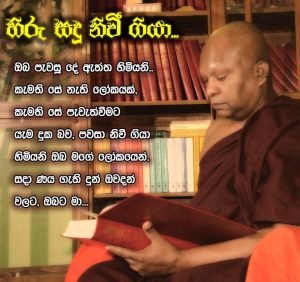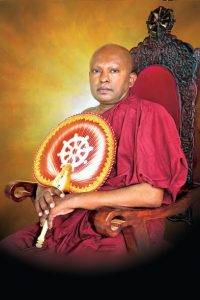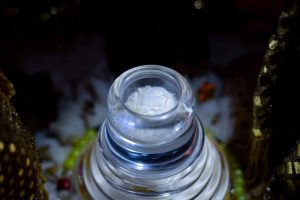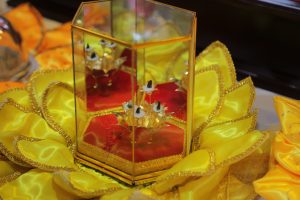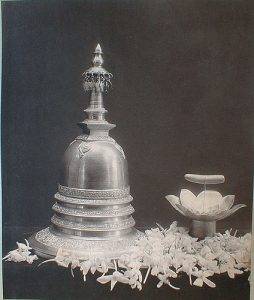March 9, 2017; revised February 6, 2018; December 18, 2022; July 6, 2023 (#9)
1. It is with great sadness that I report the Parinibbāna of my Noble teacher, Waharaka Abhyaratanalankara Thēro, a month ago, on February 9, 2017.
- Even though he had not confirmed attaining Arahanthood several years before passing away, he declared that he would not be reborn again. That means he would at least reach the Antara Parinibbāna state; see the video below.
- The Antara Parinibbāna state is reached when someone dies with three samyōjanā of kāma rāga, rūpa rāga, and arūpa rāga removed. (But without the removal of māna, uddacca, and avijjā samyōjanā). Then one cannot grasp a new bhava in any of the 31 realms).
- The gandhabba would still survive the death of the body and come out and stay alive until the kammic energy for the human bhava is exhausted. Since a new bhava cannot be grasped, anupadisēsa Nibbāna will occur. That is explained at the discussion forum “Antara Parinibbana” and in the post “Gandhabba State – Evidence from Tipiṭaka.”
- From the accounts below, it appears that he did attain Parinibbāna (i.e., bypassed the Antara Parinibbāna state) at the dying moment.
2. When the news came out first, it was unclear whether the Thēro had passed away or whether he was in Nirōdha Samāpatti. Breathing stops while one is in Nirōdha Samāpatti, but the body does not get cold. The body was warm for six days but started to get cold. Therefore, his death was not declared for six days.
- Even though I made trips to Sri Lanka in 2014 and 2015, I did not get an opportunity to meet him because he was not well.
3. He was the first person to extract the true meanings of many critical Pāli words in the Tipiṭaka in recent times— after hundreds of years.
- His Patisambhidhā Ñāna (the knowledge to extract the meanings of words) was at the same level as many renowned Arahants at the time of the Buddha.
4. As I discussed in the post, “Four Conditions for Attaining Sōtapanna Magga/Phala,” one has to learn the correct Dhamma from a Buddha or a true disciple of the Buddha. He was able to bridge a gap that will hopefully last until the end of the Buddha Sāsana (Ministry) of Buddha Gotama, i.e., for 2400 years from now for a total of 5000 years.
- I am grateful to his followers in Sri Lanka (Ven. Attidiye Sudheethadheera and others) who made recordings of thousands of hours of his dēsanā over the years. They have organized those recordings here: “Waharaka Sadaham dēsana” (updated September 11, 2017).
- Unfortunately, those are available only in the Sinhala language. I will try to convey these teachings in English on this website.
-
- I was able to meet Ven. Walasmulle Abhaya and Ven. Attidiye Sudheethadheera (both laypeople then) on a trip to Sri Lanka in early 2014 and 2015. They provided me with many dēsana recordings before they became available online. I am also grateful to Dr. Neranga Abeysinghe, with whom I had many discussions. He also updated me on recent events of Waharaka Thēro‘s last days.
- Ven. Walasmulle Abhaya conducts regular dēsanā and meditation sessions. Recordings of those at “Nirapekshathwayemaga.”
- September 7, 2017: I came to know about Ven yesterday. Rathupasketiye Vimukthirathana in Sri Lanka. His desanas (in Sinhala) at: “Ariya Asankathaya.”
- August 15, 2019: I have forgotten to add a link to a good set of English dēsanā: “Dharmayai Obai Sermons – English (From 2017-07-30)“. I have not met this Venerable, but these dēsanās are based on Waharaka interpretations.
- July 18, 2020: Cultivating jhāna is an excellent way to progress on the Path. However, initially, those jhānās are anariya in nature. As one makes progress, they will be converted to Ariya jhāna. Some people may falsely believe that getting into jhāna necessarily means magga phala. Furthermore, even the first Ariya jhāna requires the REMOVAL of kāma rāga. See, “Samādhi, Jhāna (Dhyāna), Magga Phala.”
5. April 28, 2018: Here is a desana by Waharaka Thero where he presents clear evidence that jhāna is not necessary to attain magga phala. (it is in the Sinhala language; listen to it around the 3-minute mark):
ධ්යාන සහ සමාධි (ක්ෂණික, අර්පණා, උපචාර)
-
- However, cultivating jhāna is an excellent way to progress on the Path, even after (or especially after) getting to the Sotapanna stage.
- The main point Thero makes is that we know that there are jāti Sōtapannas born in the human realm. But if a jhāna were REQUIRED to attain the Sōtapanna stage, then that person WOULD NOT be born in the human realm, but in a Brahma realm corresponding to that jhāna.
- Furthermore, listening to the correct Buddha Dhamma or attaining jhāna does not make one a Sōtapanna. Devadatta listened to many discourses from the Buddha but could not attain the Sōtapanna stage of Nibbāna.
- The critical point is that without comprehending Tilakkhana, just being able to get to jhāna is useless. But one can use jhāna effectively to comprehend Tilakkhana. The best way to verify that one has attained Ariya jhāna is to check whether one has lost any desire for all sensory pleasures (including sex.)
6. Last but not least, I must also express my gratitude to Ven. Meevanapalane Dhammalankara, who had been in close association with the Waharaka Thēro. I first came across these correct interpretations when I came across one of his dēsanā on the internet on July 30, 2013.
- Ven. Meevanapalane Dhammalankara’s dēsanā at “Sirisaddharmaya“.
7. December 12, 2020: I listened to a series of desanas from Susila Thero over the past few weeks. He is in Sri Lanka, and these discourses are in Sinhala. These are excellent and provide deep insights.
- Those who understand the Sinhala language can follow these discourses at “Lowthuru Arana ලොව්තුරු අරණ“
- I will, of course, incorporate those new insights in my posts.
- December 15, 2020: The contents in the above long discourses have been separated into topics at the following website (also in Sinhala.) I am not sure how well that is done. “දහම් ආලෝකය-Dham Alokaya“
8. September 6, 2021: I listened to a series of desanas by a 16-year-old Sri Lankan over the past few months. He recently became a bhikkhu by the name of Ven. Botale Siri Ariya Vimutti.
- It is apparent to me that to teach Buddha Dhamma with such insight at such a young age, he is likely to be a Jāti Sotapanna.
- Those who understand the Sinhala language can Google “Ven. Botale Siri Ariya Vimutti” to find his discourses.
9. July 6, 2023: Recently, I came across the following set of discourses in the Sinhala language: “Nibbida නිබ්බිදා“
- These discourses go to deep levels of Buddha Dhamma, and I am highly impressed.
10. June 6, 2017: I received some pictures of “dhātu” collected after the cremation of Waharaka Thēro‘s body. Some of an Arahant‘s bones become crystallized. These are called “dhātu,” and they cannot be destroyed by fire or anything else. I selected the following two pictures out of many sent by Ven. Attidiye Sudheethadheera and Dr. Neranga Abeysinghe.
11. By the way, here is a historical picture of the “Tooth relic” of the Buddha kept at the “Daladā Maligāwa” in Kandy, Sri Lanka:
- Such Dhāthu of the Buddha or an Arahant are considered to be indestructible up to the end of the current “Buddha Sāsana,” which will last roughly another 2500 years.
12. Here are two youtube videos of the funeral of the most venerable Thēro (the speech by Mr. Chandana Siriwardhana — where he stated the possibility of Antarā Parinibbāna of the Thēro — is in Sinhala language):

